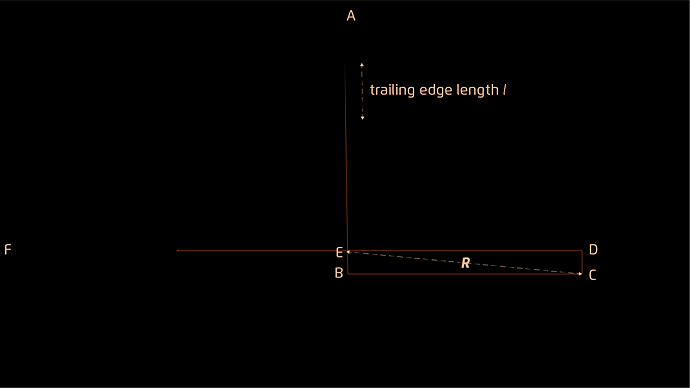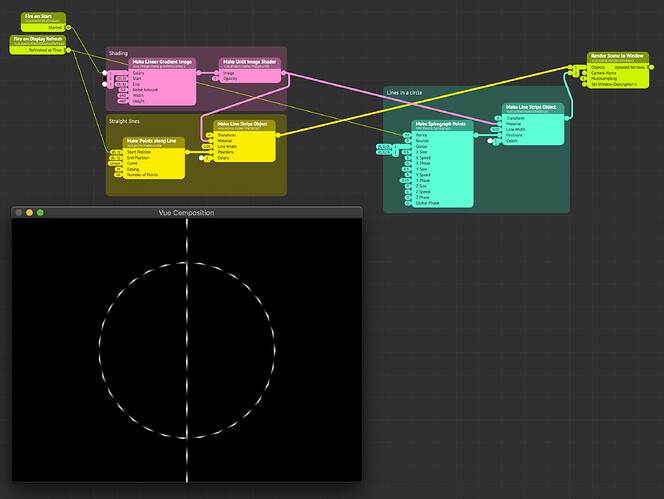this is a pretty standard thing to do in motion graphics and comping software. drawing a line starting at point A going to point B, with variable inputs for speed of movement of leading point of the line, length of the full opacity line, length l of the trailing edge of the line that gets opacity applied.
if a functional sub-comp can be made for drawing a line from A to B then it can be reused to draw from B to C, C to D, and D to E, with the parent level composition calculating the points A, B, C, D and E from the coordinates of rectangle R an triggering the sub-comps the that’s that, I just need to solve the opacity masking issue one of two ways I am envisaging.
I’m pretty clear how I’d go about it in other software. wondering for the optimal method to do the animation of ‘drawing’ a line with a trailing or leading ‘edge’ that has opacity mask applied. In QC I’d go for animating a gradient image to apply as opacity mask. Not sure how to do that in Vuo, I’m pretty uncomfortable in Vuo applying image effects as opacity masks to other objects as I find the coordinate system unintuitive so far for me.
An alternative method would be to draw ten short lines each length l/10 and set them to step in opacity from 90% down to 0% and have them chase each other.
there’s a family simple tool built into Adobe After Effects for ‘drawing lines’ and applying opacity. but this is only step one of a sequence of effects, unfortunately Vuo doesn’t export to an Adobe AE plugin binary (only Motion/FCP X) so I can’t combine the very simple AE tools for doing this with the other things I need VUO for. (or QC if I have to!)
Would really like to see Vuo export to BlackMagic Design’s DaVinci NLE/VFX application from BMD (which would be a really smart move I think given DaVinci has a good free version of the software). I’d start learning Davinci if Vuo exported to it.
Ideally I can do this all in VUO and export as an app for my video editor so they can render brand collateral effects with variable inputs for certain traits without getting into the weeds. (But OFX plugin or Adobe plugin would be amazing).
It’s just a matter of shading. With “Make Line Strips Object” an image shader will repeat the image from each control point in the line:
To increase the amount of “dots” on the line, you just increase the number of control points:
To animate the dots, you animate the image going to the shader:
2 Likes
Thanks, Martinus. I’m not sure that’s what I was after! Need to reflect on how I can apply that. I’m gong to do it in Adobe AE or QC b/c I don’t have a week to get this done! If I can then convert to VUO after the deadline, it will help me learn VUO. As you can see from my other post I find Vuo very frustrating just to learn by doing, trying stuff, reading the manual and node library, unlike QC which seems to function in a way that takes little functions and allows one to keep growing on them bit by bit.
I know Vuo has it’s advantages over QC (not least being supported!) but the learning curve is not especially pleasant (for me) whereas QC was mostly fun for me (except for learning JS inside such a hard to debug environment to do state machine stuff).
No stress! It is a bit of a different thought process. The coordinate system makes a lot more sense both mathematically and when you do 3d manipulations/work in 3d environments. Coming from pixel space and 0 - 1 / Width - Height space to that can be a bit of a shift though! I have ripped out a fair few hairs when transitioning to this kind of workflow myself. As it is standard for most applications in 3d space I guess it’s just a matter of getting to grips with it.
(Also left you an answer there ;) )
1 Like
I don’t have any issues working in [-1,1] space for X, Y and Z dimensions at all. I was flicking between pixels and width units in QC all the time for years (annoying but very necessary!) and used to do quite a bit of 3D modelling (Architecture training too).
My problems are discovering the useful Vuo patterns to do things. It’s not like raw power of semantic code that written programming languages bring (and copious code snippets to learn from) and not as effortless as QC nodal bottom up wiring. You basically can’t do anything bottom up in Vuo the way you can in QC in my opinion. Arguably with the Vuo methods comes power, but it’s frustrating for self-tuition, basically impossible without a full time effort for weeks/months. Whereas QC was possible to get instant results at whatever level you started from. Many of us who backed the Vuo beta came to QC with little to no programming background beyond school level exposure to coding…


